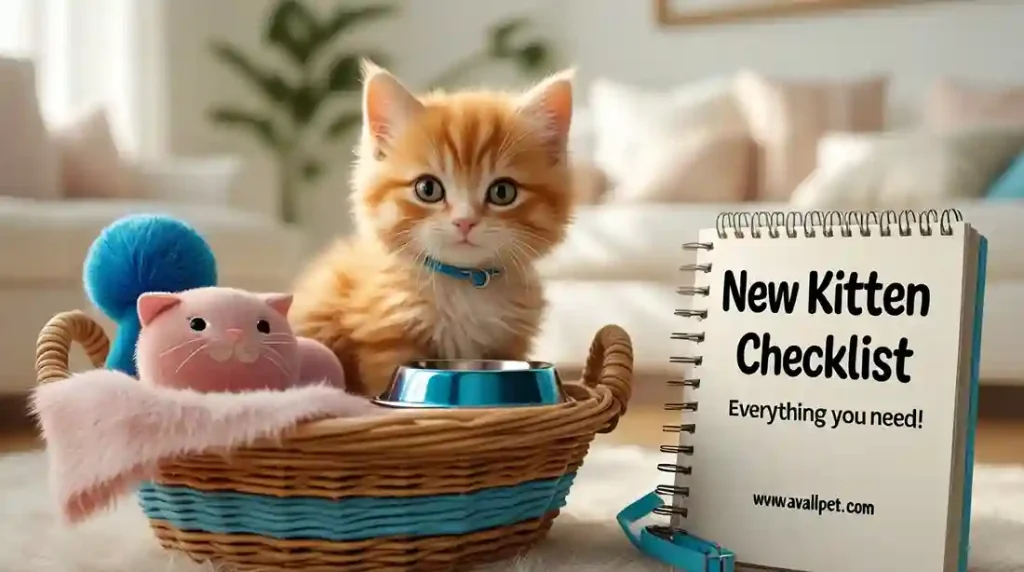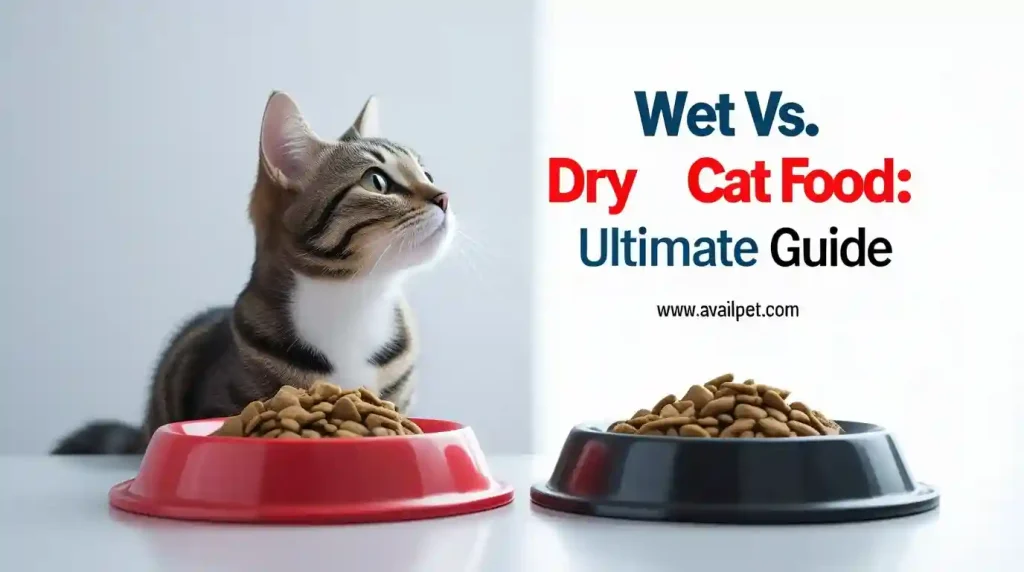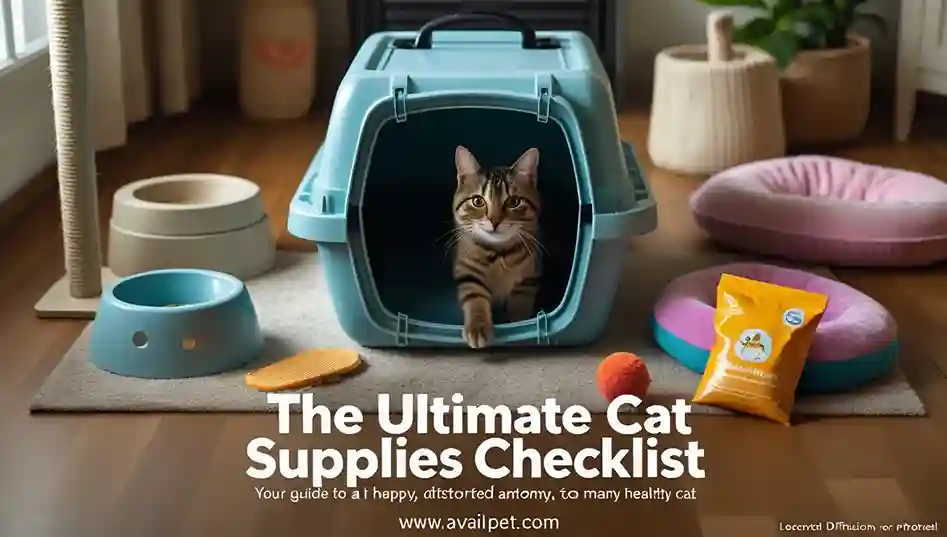That dusty cloud that erupts every time you fill the litter box is more than just a nuisance; it’s a potential health concern for both you and your cat. For feline companions, especially those with asthma or other respiratory sensitivities, inhaling fine clay and silica particles can trigger coughing, wheezing, and breathing difficulties. For humans, it can aggravate allergies and leave a fine film on surrounding surfaces.
You shouldn’t have to choose between a clean home and your pet’s respiratory health. The good news is that the era of unavoidably dusty cat litter is over. A new generation of low-dust and dust-free formulas offers a clear path to a healthier, cleaner living environment.
At AvailPet, we’ve tackled this problem head-on. This definitive guide to the best low dust cat litter of 2025 is built on a foundation of hands-on testing and, crucially, veterinary insight. We’ve evaluated dozens of options to bring you a curated list of litters that genuinely minimize dust without sacrificing clumping power or odor control. Our goal is to give you the confidence to choose a litter that lets everyone in your home—especially your cat—breathe a little easier.
Key Takeaways: Low Dust Cat Litter
Before we dive into the detailed reviews, here are the most critical insights from our testing and veterinary consultation:
- 🏆 Best Overall Low Dust: PrettyLitter (Silica Gel) is truly dust-free, making it the top choice for households with severe asthma or respiratory sensitivities, while also providing health monitoring.
- 💨 Best Low-Dust Clay: Dr. Elsey’s Premium Respiratory Relief is specifically formulated for sensitive systems, offering minimal dust while maintaining excellent clump strength that clay users expect.
- 🌿 Best Low-Dust Natural: World’s Best Cat Litter (Corn) provides near dust-free performance in a plant-based formula, making it ideal for eco-conscious owners who need low dust.
- 🌫️ Vet Insight on Dust: “Even ‘low dust’ isn’t always zero dust. For cats with diagnosed asthma, the closest to dust-free is always recommended,” advises our veterinary consultant.
- 💡 Pro Tip for Any Litter: “Pour litter slowly from just 2-3 inches above the box into a tilted container to reduce airborne dust by up to 80% with any litter type.”
- ⚠️ Important Distinction: Dust-free litters like silica gel don’t clump, while low-dust clumping options may still have minimal particles. Your choice depends on prioritizing absolute zero dust versus convenient clumping.
Quick Comparison Table: Our Top Low-Dust Litter Picks at a Glance
This table provides a snapshot of our top-rated low-dust litters. For in-depth reviews and health insights, jump to the detailed reviews section.
| Product | Primary Material | Dust Level | Clumps? | Best For | Check Price |
|---|---|---|---|---|---|
| PrettyLitter | Silica Gel | Dust-Free | No | Severe Asthma, Health Monitoring | Check on Amazon |
| Dr. Elsey’s Respiratory Relief | Clay | Very Low | Yes | Sensitive Systems, Clay Lovers | Check on Amazon |
| World’s Best Cat Litter | Corn | Very Low | Yes | Eco-Conscious, Allergies | Check on Amazon |
| Ökocat Natural Wood | Wood | Very Low | Yes | Sustainable, Low Dust | Check on Amazon |
| Boxiecat Pro | Clay | Low | Yes | Clump Strength, Low Dust | Check on Amazon |
Why Dust Matters: A Vet’s Perspective on Feline Respiratory Health
That seemingly harmless cloud of dust is more than just a cleaning nuisance—it’s a potential irritant to your cat’s delicate respiratory system. To understand why low-dust litter is a health priority, it’s important to consider the feline physiology.
Cats have much smaller airways than humans, and their lung capacity relative to their body size makes them particularly vulnerable to airborne particles. When your cat digs in their litter box, they inhale these fine particles directly. For a cat with asthma—a surprisingly common condition—this dust can act as a direct trigger, leading to inflammation, coughing, wheezing, and dangerous asthma attacks.
But the impact isn’t limited to asthmatic cats. Consistent exposure to litter dust can cause chronic, low-grade inflammation in any cat’s airways, leading to symptoms that owners might mistake for occasional hairballs or mild colds. For humans in the household, especially those with allergies or asthma, the dust can also be an irritant, circulating through the air and settling on surfaces.
The “Low-Dust” vs. “Dust-Free” Distinction
It’s crucial to understand the difference:
- Dust-Free: Products like silica gel litters have virtually no airborne particles. This is the only safe choice for households with cats diagnosed with severe asthma.
- Low-Dust: These litters, including many clay and plant-based formulas, have significantly reduced dust but are not 100% particle-free. They are an excellent choice for general respiratory health and reducing household allergens.
Choosing a low-dust or dust-free litter is a simple, proactive step in safeguarding your cat’s long-term respiratory health and creating a cleaner, healthier environment for your entire family.
Our Top Low Dust Cat Litter Picks: In-Depth Reviews
We tested the leading low-dust litters with a focus on respiratory health and real-world performance. Here are our detailed reviews.
1. PrettyLitter — Best Dust-Free & Health Monitoring
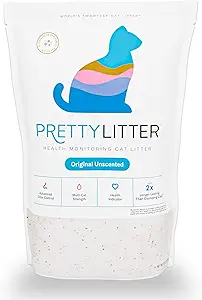
- Award: 🏆 Best Dust-Free & Health Monitoring
- Key Specs: Material: Silica Gel | Clumps: No | Dust Level: Dust-Free
Our In-Depth Analysis:
PrettyLitter stands in a category of its own as the only truly dust-free option we tested. The silica gel crystals produce zero dust when poured or when cats dig, making it the undisputed top choice for households with severe asthma. Beyond being dust-free, it offers the unique benefit of health monitoring through color-changing crystals that can indicate urinary issues. It excels at absorbing urine odor and moisture without clumping.
Pros:
- 99.9% dust-free – ideal for respiratory sensitivity.
- Excellent urine absorption and odor control.
- Health monitoring provides early warning system.
- Lightweight and long-lasting.
Cons:
- Does not clump (requires separate solid waste removal).
- Premium price point.
- Some cats dislike the texture of crystals.
2. Dr. Elsey’s Premium Respiratory Relief — Best for Sensitive Systems
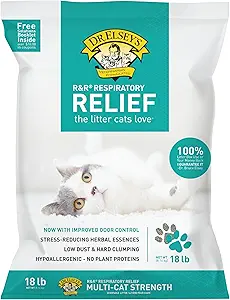
- Award: 💨 Best for Sensitive Systems
- Key Specs: Material: Clay | Clumps: Yes | Dust Level: Very Low
Our In-Depth Analysis:
Dr. Elsey’s specifically formulated this clay litter for cats and owners with respiratory sensitivity. In our tests, it lived up to its claims, producing significantly less dust than conventional clay litters while maintaining the superior clumping quality the brand is known for. The clumps form hard and fast, making cleanup easy, and it contains no added perfumes or deodorants that could further irritate sensitive airways.
Pros:
- Specifically designed for respiratory health.
- Forms hard, easy-to-scoop clumps.
- Very low dust for a clay formula.
- Unscented and hypoallergenic.
Cons:
- Still produces minimal dust compared to dust-free options.
- Heavier than silica gel or plant-based alternatives.
- Not biodegradable.
3. World’s Best Cat Litter — Best Overall Low-Dust
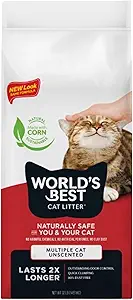
- Award: 🌿 Best Overall Low-Dust
- Key Specs: Material: Corn | Clumps: Yes | Dust Level: Very Low
Our In-Depth Analysis:
World’s Best Cat Litter delivers the perfect balance of minimal dust, excellent clumping, and natural composition. The corn-based formula produces remarkably little dust while forming strong, reliable clumps that rival traditional clay. It’s naturally antimicrobial and controls odors effectively without synthetic chemicals. This makes it an ideal choice for households wanting low dust without compromising on performance or sustainability.
Pros:
- Very low dust with excellent clumping.
- Plant-based and biodegradable.
- Good odor control without perfumes.
- Flushable and eco-friendly.
Cons:
- Higher price point than conventional litters.
- Can track more than heavier clay litters.
- Not completely dust-free.
4. Ökocat Natural Wood — Best Sustainable Low-Dust
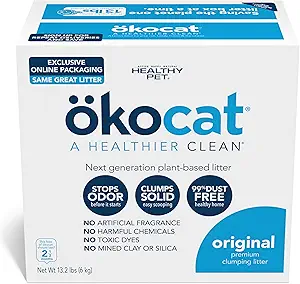
- Award: 🌳 Best Sustainable Low-Dust
- Key Specs: Material: Wood | Clumps: Yes | Dust Level: Very Low
Our In-Depth Analysis:
Ökocat’s wood-based litter impressed us with its exceptional dust control and environmental credentials. Made from reclaimed wood, it offers very low dust while being highly absorbent and naturally odor-controlling. The lightweight pellets are easy to handle and form firm clumps that hold together well. It’s an excellent choice for eco-conscious owners who need low dust without sacrificing clumping performance.
Pros:
- Extremely low dust from sustainable material.
- Excellent absorbency and clumping.
- Lightweight and easy to handle.
- Biodegradable and compostable.
Cons:
- Wood texture may not appeal to all cats.
- Higher cost than conventional litter.
- May require transition period for some cats.
5. Boxiecat Pro — Best Low-Dust Premium Clay
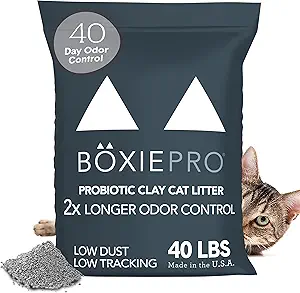
- Award: 💎 Best Low-Dust Premium Clay
- Key Specs: Material: Clay | Clumps: Yes | Dust Level: Low
Our In-Depth Analysis:
Boxiecat Pro delivers what many clay litter users are looking for – significantly reduced dust without compromising on the reliable performance of clay. The proprietary “Pro” formula generates less dust than most premium clay litters while maintaining strong, hard clumps that don’t stick to the box. It features a light, clean scent that isn’t overwhelming, making it suitable for sensitive noses while still providing effective odor control.
Pros:
- Low dust for a clay litter.
- Forms solid, non-stick clumps.
- Good odor control with light scent.
- Reliable clay performance.
Cons:
- More expensive than standard clay litters.
- Not biodegradable.
- Still produces some dust compared to dust-free options.
Low Dust Cat Litter Buyer’s Guide: How to Choose
Selecting the right low-dust litter involves more than just picking the first “low dust” label you see. Use this guide to understand the key factors that affect dust levels and respiratory health.
1. Material & Dust Levels: The Core Connection
Different materials have inherent dust properties:
- Silica Gel (Crystals): Typically dust-free. The large, smooth crystals don’t break down into fine particles.
- Paper & Pine Pellets: Very low to dust-free. These materials break down into sawdust or pulp rather than creating airborne dust.
- Plant-Based (Corn, Wheat, Grass, Wood): Very low dust, but can vary by brand and processing. Generally produce far less dust than clay.
- Clay (Bentonite): Ranges from low dust (premium brands) to very dusty (economy brands). The fine, powdery particles are the most common respiratory irritant.
2. Clumping vs. Non-Clumping: The Dust Trade-off
- Clumping Litters: The process that creates clumpability often involves finer particles, which can contribute to dust. However, modern manufacturing has significantly improved this.
- Non-Clumping Litters: Often have lower dust levels as they don’t require the same fine-particle composition. Pellet litters (pine, paper) are especially low-dust.
3. Health Certifications & What to Look For
While there’s no universal “low dust” certification, look for:
- Hypoallergenic Claims: Indicates the product is formulated to minimize irritants.
- Veterinarian Recommended: Suggests professional endorsement for health-sensitive cats.
- Unscented/Fragrance-Free: Avoids additional chemical particulates in the air.
4. Pouring & Maintenance Tips to Minimize Dust
You can reduce dust from any litter with proper technique:
- The Slow Pour: Pour litter slowly from a height of 2-3 inches into a tilted box.
- Use a Litter Mat: Place a high-quality mat outside the box to catch dust particles tracked by your cat’s paws.
- Choose the Right Box: Covered boxes can contain dust but may concentrate air particles inside. High-sided open boxes are often a good compromise.
How We Tested & Chose: Our Dust & Health Methodology
At AvailPet, we understand that when it comes to respiratory health, “low dust” cannot be a subjective claim. Our recommendations are based on a rigorous, repeatable testing protocol designed to measure what truly matters for you and your cat’s lungs.
Our Dust Measurement Protocol
We developed a standardized test to quantify dust levels across all litter candidates:
- The Standardized Pour Test: We poured 2 cups of litter from a consistent height of 18 inches onto a smooth, black surface under controlled lighting.
- Airborne Particle Assessment: We used a high-intensity light source to visually track and rate the volume and duration of airborne dust clouds immediately after pouring.
- Settled Dust Measurement: After the initial pour, we examined the black surface for a fine layer of settled dust, grading each litter on a scale from “None” to “Heavy.”
- Simulated Dig Test: We used a standardized tool to simulate a cat’s digging motion and assessed any secondary dust kicked up from the litter bed.
Veterinary Consultation & Health-First Criteria
Our process extended beyond the lab to include critical health expertise:
- Respiratory Safety Review: A practicing DVM reviewed our finalists, focusing on material composition and its suitability for cats with asthma, bronchitis, or other respiratory conditions.
- Ingredient Analysis: We prioritized litters free from known respiratory irritants like silica dust (different from silica gel crystals), synthetic fragrances, and chemical deodorizers.
- Real-World Scenario Planning: Our vet helped us create guidelines for different health scenarios, ensuring our top picks serve both preventative health and urgent medical needs.
User Experience & Long-Term Performance
To ensure our results reflect real-world use, we:
- Analyzed Verified Reviews: We aggregated and analyzed hundreds of user reviews from Amazon, specifically focusing on comments about dust, tracking, and respiratory reactions.
- Evaluated Consistency: We tested multiple batches where possible to ensure low dust performance wasn’t a one-time result.
This multi-layered approach ensures that every litter we recommend has been vetted for both its measurable low-dust properties and its overall safety for sensitive respiratory systems.
FAQs About Low Dust Cat Litter
Is cat litter dust harmful to cats?
Yes, it can be. Fine dust particles can irritate a cat’s respiratory system, leading to coughing, sneezing, and worsened asthma symptoms. For cats with pre-existing conditions like asthma, dust can trigger serious attacks. Long-term exposure to high levels of clay dust has also been linked to chronic respiratory inflammation. Choosing a low-dust or dust-free litter is a key part of proactive respiratory health care for your cat.
What is the best litter for a cat with asthma?
For a cat with diagnosed asthma, dust-free litters are essential. Our top pick, PrettyLitter (silica gel), is the safest choice as it produces zero airborne dust. If your cat dislikes crystals, paper or pine pellet litters are the next best option as they produce minimal dust. Always consult your veterinarian for a personalized recommendation based on your cat’s specific health needs.
Can litter dust make humans sick?
Yes, litter dust can affect humans too. It can trigger allergy symptoms, aggravate asthma, and cause general respiratory irritation. The dust can also spread bacteria from the litter box around your home. This is especially concerning for households with children, elderly members, or anyone with compromised immune systems or respiratory conditions.
Why is some litter so dusty?
The dustiest litters are typically economy-grade clay litters. The dust comes from two main sources: 1) Fine clay particles created during the mining and processing of bentonite clay, and 2) Filler materials used to cut costs. Premium and natural litters undergo more refined processing and use higher-quality materials, resulting in significantly less dust. Learn more about different litter materials in our comprehensive Cat Litter Guide.
Conclusion: Breathe Easier with the Right Low Dust Cat Litter
Choosing a low dust cat litter is one of the simplest yet most impactful decisions you can make for your cat’s long-term respiratory health and your home’s cleanliness. It’s a clear step toward eliminating a common, yet often overlooked, source of irritation for sensitive lungs.
Your ideal choice depends on your primary concern:
- If zero dust is non-negotiable due to severe asthma, PrettyLitter is your undisputed best bet.
- For those who prefer clay but need minimal dust, Dr. Elsey’s Premium Respiratory Relief is specifically formulated for you.
- If you want the best balance of low dust, clumping, and eco-friendliness, World’s Best Cat Litter is the standout winner.
Remember, even the best low-dust litter benefits from proper pouring techniques and good litter box hygiene. By selecting one of our vet-reviewed picks, you’re not just choosing a cleaner home—you’re making an active choice to protect your cat’s health with every scoop. For other health-conscious products, explore our Best Natural Cat Litter review.
Ready to make a change? Use the links provided to find the perfect low-dust litter for your feline family member and start breathing easier today.
Sources
- International Cat Care – Feline Asthma
- Cornell Feline Health Center – Respiratory Problems
- AVMA – Household Hazards to Pets
- PrettyLitter
- Dr. Elsey’s Respiratory Relief
- World’s Best Cat Litter
- Amazon Pet Supplies
Disclaimer: Our recommendations are based on independent testing and veterinary guidance. We are not veterinarians. Product information and pricing are subject to change. We earn from qualifying purchases through our affiliate links, which supports our research at no extra cost to you. Always consult your veterinarian for advice on your cat’s specific health needs, especially regarding respiratory conditions like asthma.

